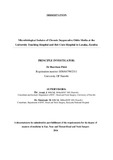| dc.description.abstract | Background: Chronic Suppurative Otitis Media (CSOM) is a common cause of hearing loss
and many complications such as meningitis. Many approaches to treatment of CSOM have
been unsatisfactory because CSOM microbiological isolates as well as their sensitivity
patterns vary from place to place.
Objectives: To determine the pattern of microbiological isolates of CSOM and the
demographic characteristics of patients with CSOM at the University Teaching Hospital,
(UTH) and Beit Cure Hospital (BCH) in Lusaka, Zambia.
Study design: The study was a hospital based Cross sectional descriptive study
Study Setting: The study was conducted at the ENT outpatient clinics of UTH and BCH in
Lusaka, Zambia.
Methodology: 100 CSOM patients were included in the study. Quantitative data on the
participants’ demographic details and clinical features were obtained using structured
questionnaires. The middle ear discharge was aseptically collected using a sterile cotton
swab. In the laboratory, samples were inoculated on agar media to isolate microorganisms
and antibiotic susceptibility testing was done using Kirby Bauer method as per CLSI
guidelines.
Results: Out of the 100 CSOM patients studied, 33(33%) were children below 18yrs and
67(67%) were adults. 59(59%) of the patients had unilateral CSOM while 41 had bilateral
CSOM which gave a total of 141 ears that were analyzed. 119(84.4%) had pure cultures,
20(14.2%) had mixed cultures and 2(1.4%) had no growth. Of the 169 microbiological
isolates, the most frequent isolates were Proteus mirabilis 49(29.0%), Pseudomonas
aeruginosa, 32(18.9%), coagulase negative Staphylococcus 18(10.7%) and klebsiella
pneumonie 17(10.1%). High sensitivity rates were revealed to Gentamycin (64-100%),
meropenem (68-100%), ceftazidime (85-100%), ceftriaxone (64-80%), and ciprofloxacin (66-
88%). High resistance rates were recorded to Amoxicillin-clavulanate (as high as 100%),
ampicillin (as high as 100%), tetracycline (as high as 91.2%) and cotrimoxazole (as high as
100%) and penicillin (as high as 100%).
Conclusion: Proteus mirabilis was the most dominant microbiological isolate followed by
Pseudomonas aureginosa. The isolated microorganisms had high susceptibility rates to
gentamycin, meropenem, ceftazidime, ceftriaxone and ciprofloxacin. There were high
resistance rates to amoxicillin-clavulanate, ampicillin, tetracycline, cotrimoxazole and
penicillin. | en_US |
| dc.description.department | a
Department of Psychiatry, University of Nairobi, ; bDepartment of Mental Health, School of Medicine,
Moi University, Eldoret, Kenya | |



